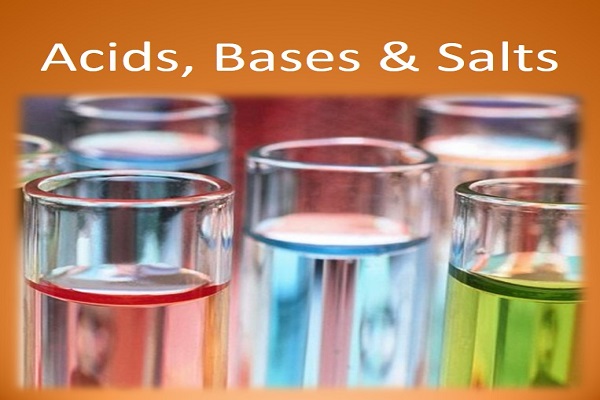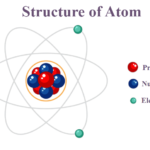1. Acids
- An acid is a compound, produce hydrogen ions, H+ (aq), in solution, which are responsible for their acidic properties.
- According to Bronsted-Lowry theory, an acid is any species that can donate a proton to another species.Hydrogen ions cannot exist alone, but they exist after combining with water molecules.so, on dissolving in water yields hydronium ions (H3O+) as the only positive ions.The presence of hydrogen ions make acids strong and good electrolytes.
- Strong Acid: Examples of strong acids are: hydrochloric acid, sulphuric acid, nitric acid etc. Weak Acid: Examples are: acetic acid, formic acid, carbonic acid etc.
Acids are generally sour in taste and corrosive.
- Indicators: Test whether a substance is acidic or basic.
- Eg: Turmeric, litmus, china rose petals (Gudhal), etc., are some of the naturally occurring indicators.
- Litmus is extracted from lichens a plant belonging to the division Thallophyta. It has a purple colour in distilled water. When added to an acidic solution, it turns red and when added to a basic solution, it turns blue.
- The solutions which do not change the colour of either red or blue litmus are known as neutral solutions. These substances are neither acidic nor basic.
- Olfactoryindicators: There are some substances whose odour changes in acidic or basic media.
Uses of Acids
Acids are obtained from two different sources. They can be organic or mineral acids. All acids have some common characteristic properties.
| Sources of the acid | Name of the acid |
| Vinegar | Acetic acid |
| Citrusfruits | Citric acid |
| Grapes,tamarind,gooseberries | Tartaric acid |
| Sour milk | Lactic acid |
| Apples | Malic acid |
| Curd | Butyric acid |
| Tea,tomatoes | Oxalic acid |
| Stingofredants andbees | Formic acid |
| Proteins | Amino acids |
| Guava,oranges | Ascorbic acid |
Note: The process of dissolving an acid or abase in water is a highly exothermic one. The acid must always be added slowly to water with constant stirring.
2. Bases and Alkalis
- A Base is a substance that gives OH-ions when dissolved in water. Bases are usually metal hydroxides (MOH).
- According to Bronsted-Lowry theory, a base is a proton acceptor.Bases are soapy substances with a bitter taste.The strength of a base depends on the concentration of the hydroxyl ions when it is dissolved in water.
- Bases soluble in water are called alkalies. All alkalies are bases but all bases are not alkalies.
Strong Base:
Examples: Sodium hydroxide: NaOH (caustic sod(a), Potassium hydroxide: KOH(caustic potash), Calcium hydroxide: Ca(OH)2.
Weak Base:
Examples: Magnesium hydroxide: Mg(OH)2, Ammonium hydroxide: NH4OH.
- Salt: Asalt is an ionic compoundthat can be formed by the neutralization reaction of an acid and a base.
USES OF SALTS IN INDUSTRIES:
- Sodium chloride is used in the manufacture of chlorine, caustic soda, washing soda and baking soda.
- Ammonium salts are used as fertilizers.
- Potassium nitrate is used in the manufacture of gun powder and fire works.
- Silver bromide is used in photography.
- Potassium Chlorate is used in the match industry.
- Aluminium sulphate is used in preparing alums.
pH SCALE
The p in pH stands for ‘potenz’ in German, meaning power. The scale that measures the strength of an acid or a base is called the pH scale. This value lies between 0 and 14.
- Higher the hydronium ion concentration, lower is the pH value.
- The pH of a neutral solution is7.Values less than 7 on the pH scale represent an acidic solution. As the pH value increases from 7to14, it represents an increase in OH– ion concentration in the solution, that is, increase in the strength of alkali.
- Most food crops grow best at a PH of 7-7.8. If the soil is too acidic then its pH can be raised by adding lime (or slaked lim(e) which neutralizes the excess acid in the soil. Similarly, if the soil is too alkaline then its pH can be lowered by adding gypsum or some other substance which can neutralize the excess alkali present in the soil.
- The medium in our stomach is highly acidic and has pH around 1.2. Our stomach produces hydrochloric acid which helps in digestion of food. Magnesium hydroxide (Milk of magnesi(a), a mild base, is an antacid which neutralises the excess acid.
- Tooth decay starts when the pH of the mouth is lower than 5.5.
- Acid Rain- When pH of rain water is less than 5.6, it is called acid rain.
- Gastricjuice-1.2
- LemonJuice-2.2
- Pure water- 7.4
- Milk of magnesia- 10
- Sodium hydroxide solution- 14
- Blood pH : For proper functioning our body needs to maintain blood pH between 7.35 and 7.45. Values of blood pH greater than 7.8 or less than 6.8 often results in death.
- Note – The atmosphere of venus is made up of thick white and yellowish clouds of sulphuric acid.
Featured image courtesy: science.olympiadsuccess



